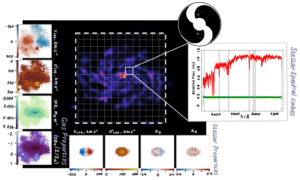I work at ICRAR/UWA as a Research Associate, specialising in numerical simulations and galaxy dynamics. My research interests lie outside our own galaxy – in trying to understand how the diversity of galaxies that we observe around us have formed and evolved, specifically by studying their stellar kinematic signatures. I am also keen to develop tools that allow us to more readily compare our observations and simulations. This interest extends to studying how reliable our simulations are, especially concerning velocity structure and the formation and evolution of thin galactic disks.
My research:

I completed my PhD in 2020 under the supervision of Chris Power and Aaron Robotham at the UWA node of ICRAR, in which I developed the code, SimSpin, for generating mock observations of N-body and hydro-dynamical simulations and examined the effects that seeing conditions have on the kinematics we recover from IFU surveys.
Over the course of my postdoctoral research, this code has been developed further to produce spectral datacubes that reflect real survey results, in a manner agnostic to the type of simulation input and the specifics of the telescope output. We are using this code to build mock surveys for direct comparison of simulations with observations of galaxies at 3-4 Gyr ago made with the MAGPI survey. In 2024, this code was awarded the ASA Emerging Leaders in Software Development prize at the annual meeting. I was interviewed about this and my experiences as a RSE (Research Software Engineer) by the Australian Research Data Commons, who sponsored the prize, which you can read about here.
This code is open source and documented for ease of use. We provide a number of examples and walk-through adventures for new users. There is also a web application, built and supported through ADACS and Data Central for the creation of mock data products for direct comparison with ongoing IFS surveys such as SAMI, Hector and MAGPI.

Past & ongoing projects:
We have been using SimSpin to investigate the evolution of stellar kinematics between z~0.3 to 0 in a number of different cosmological simulations with the MAGPI survey. This data is under construction and will be released via a formal data release in the final quarter of 2024.
SimSpin has been used to develop empirical corrections for the effects of seeing on observable kinematics, to build data sets for machine learning algorithms attempting to uncover the intrinsic link between observable properties of galaxies and their underlying 3D shape, as well as to explore the formation pathways of slow rotating, massive elliptical galaxies and passive spiral galaxies in the EAGLE simulation.
If you are interested in using SimSpin for your own research, but aren’t sure where to start, please reach out via email. Or, check out the documentation for a walk-through here.
Publications
You can find a comprehensive list of my publication record on this NASA ADS library.
ICRAR Statement
The content of this page is maintained by Kate Harborne, please contact them with any questions or comments on this content.